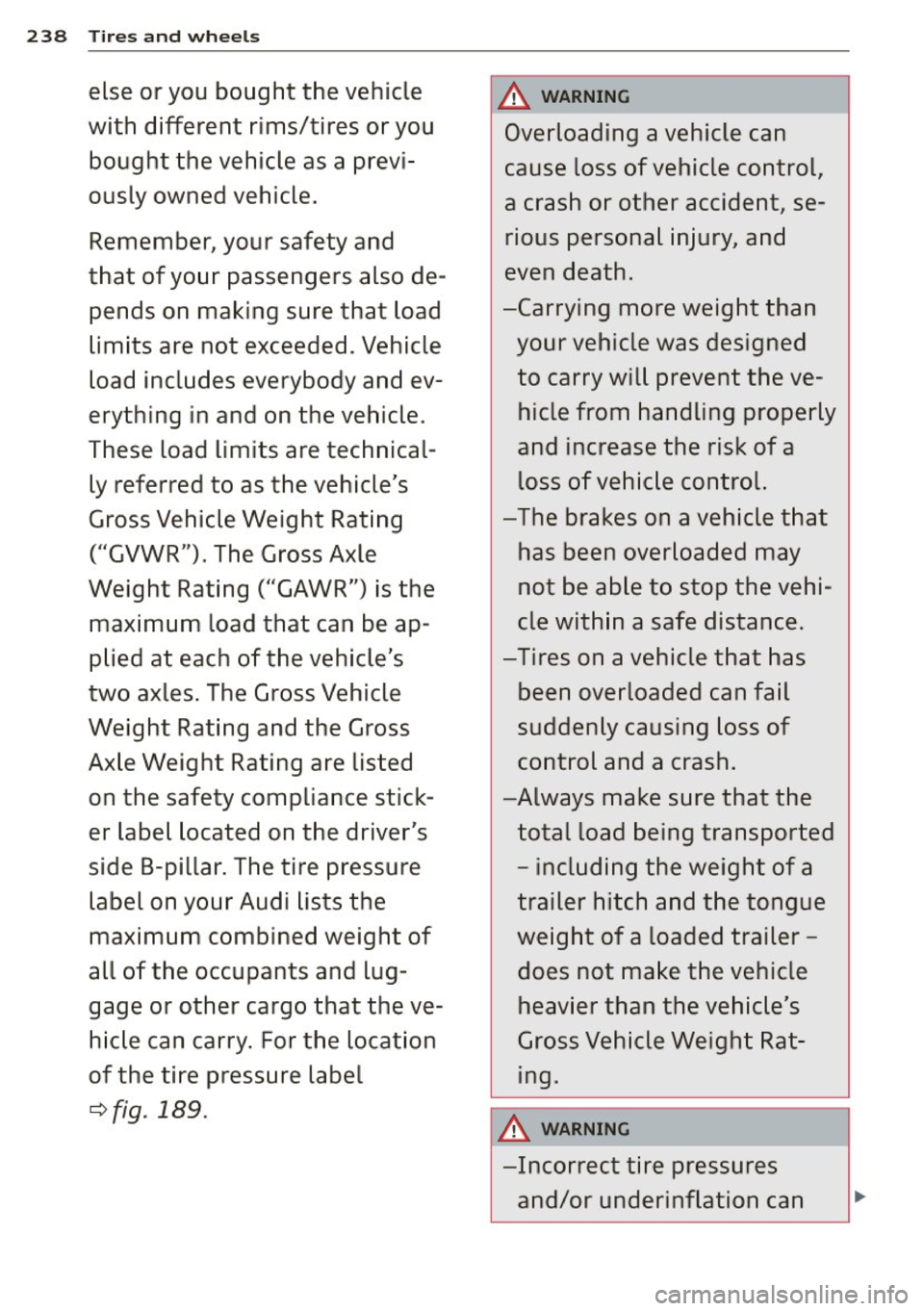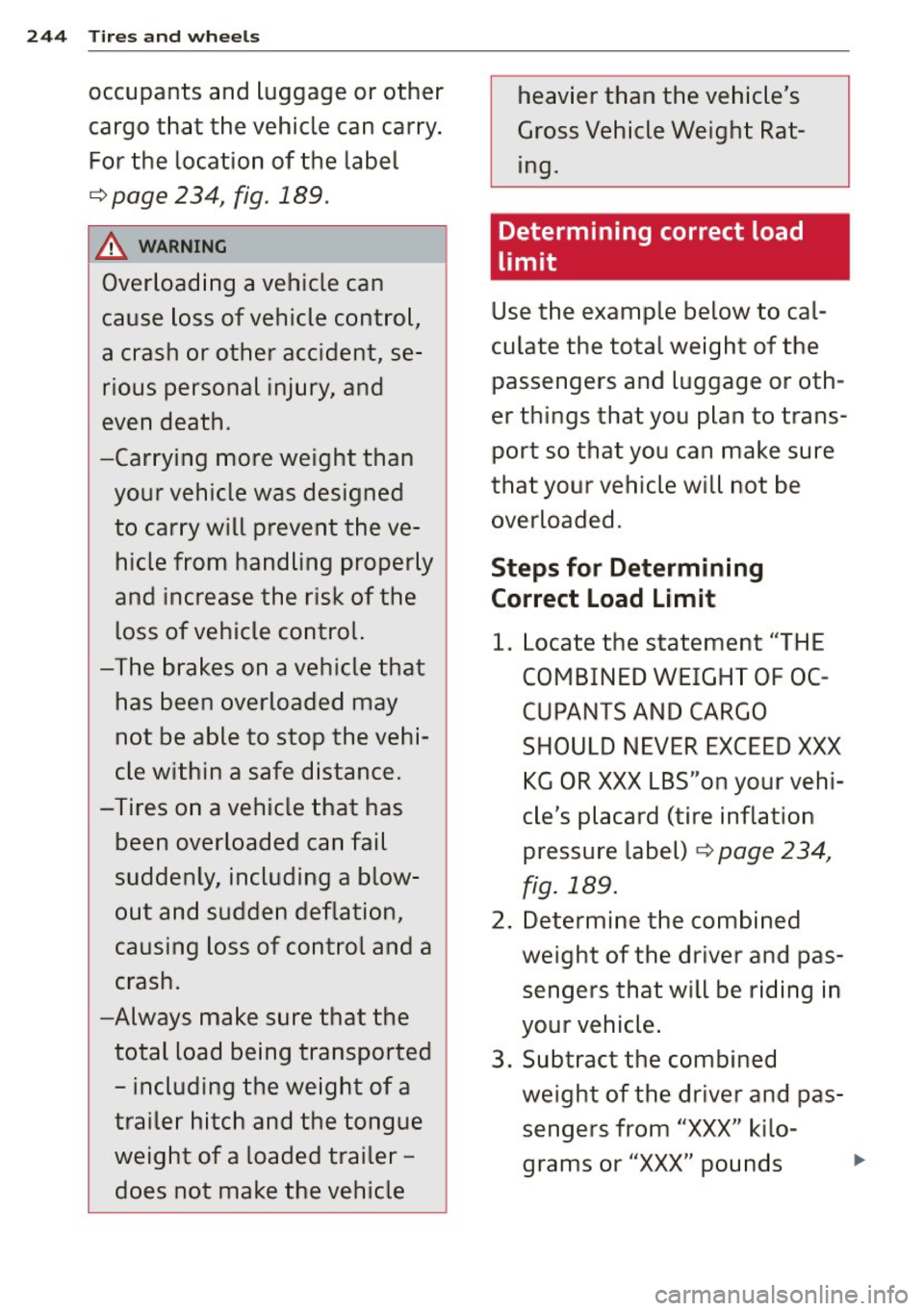2015 AUDI S4 brakes
[x] Cancel search: brakesPage 231 of 304

-If you notice unusual vibration or if the vehicle pulls to one side when driving, al
ways stop as soon as it is safe to do so and check the
wheels and tires for dam age.
(D Note
-Please note that summer and winter tires are de
signed for the conditions
that are typical in those sea
sons. Audi recommends using winter tires during the
winter months. Low tem peratures significantly de
crease the elasticity of
summer tires, which affects
traction and braking ability.
Tires and wheels 229
If summer tires are used in
very cold temperatures, cracks can form on the tread bars, resulting in perma
nent tire damage that can
cause loud driving noise and unbalanced tires. Audi is not
responsible for this type of
damage.
-Burnished, polished or chromed rims must not be used in winter road condi
tions. The surface of the
rims does not have suffi
cient corrosion protection
for this and could be perma
nently damaged by road salt
or similar substances.
•
•
'
Glossary of tire and loading terminology
Accessory weight
means the combined weight (in
excess of those standard items
which may be replaced) of auto matic transmission, power
steering, power brakes, power
windows, power seats, radio, and heater, to the extent that
these items are available as fac
tory-installed equipment (whether installed or not).
Aspect ratio
means the ratio of the height to
the width of the tire in percent. Numbers of 55 or lower indi
cate a low sidewall for im proved steering response and
better overall handling on dry
pavement.
Page 233 of 304

Maximum load rating
means the load rating for a tire
at the maximum permissible in
flation pressure for that tire.
Maximum loaded vehicle
weight
means the sum of:
(a) Curb weight
(b) Accessory weight
(c) Vehicle capacity weight, and
(d) Production options weight
Maximum (permissible)
inflation pressure
means the maximum cold infla
tion pressure to which a tire
may be inflated. Also called
"maximum inflation pressure."
Normal occupant weight
means 150 lbs. (68 kilograms)
times the number of occupants seated in the vehicle up to the
total seating capacity of your
vehicle.
Occupant distribution
means distribution of occu pants in a vehicle.
Outer diameter
means the overall diameter of
an inflated new tire.
Tires and wheels 231
Overall width
means the linear distance be
tween the exteriors of the side
walls of an inflated tire, includ ing elevations due to labeling,
decorations, or protective bands or ribs.
Ply
means a layer of rubber-coated
parallel cords.
Production options weight
means the combined weight of
those installed regular produc
tion options weighing over 5 lbs. (2 . 3 kg) in excess of those
standard items which they re place, not previously consid
ered in curb weight or accessory
weight, including heavy duty
brakes, ride levelers, roof rack,
heavy duty battery , and special
trim.
Radial ply tire
means a pneumatic tire in
which the ply cords that extend
to the beads are laid at sub stantially 90 degrees to the
centerline of the tread.
•
•
'
Page 240 of 304

238 Tires and wheels
else or you bought the vehicle
with different rims/tires or you bought the vehicle as a previ
ously owned vehicle.
Remember, your safety and
that of your passengers also de
pends on making sure that load
limits are not exceeded. Vehicle
load includes everybody and ev
erything in and on the vehicle.
These load limits are technical
ly referred to as the vehicle's
Gross Vehicle Weight Rating ("GVWR"). The Gross Axle
Weight Rating ("GAWR") is the maximum load that can be ap
plied at each of the vehicle's
two axles . The Gross Vehicle
Weight Rating and the Gross
Axle Weight Rating are listed
on the safety compliance stick
er label located on the driver's
side B-pillar. The tire pressure
label on your Audi lists the
maximum combined weight of
all of the occupants and lug
gage or other cargo that the ve
h icle can carry . For the location
of the tire pressure label
¢fig . 189.
.&_ WARNI NG -
Overloading a vehicle can
cause loss of vehicle control,
a crash or other accident, se
rious personal injury, and
even death.
-Carrying more weight than
your vehicle was designed to carry will prevent the ve
hicle from handling properly
and increase the risk of a
loss of vehicle control.
-The brakes on a vehicle that
has been overloaded may not be able to stop the vehi
cle with in a safe distance .
-Tires on a vehicle that has been overloaded can fail
suddenly causing loss of
control and a crash.
- Always make sure that the
total load being transported
- including the weight of a
trailer hitch and the tongue
weight of a loaded trailer - does not make the vehicle
heavier than the vehicle's
Gross Vehicle Weight Rating.
.&_ WARNI NG
-Incorrect tire pressures
and/or underinflation can
-
Page 246 of 304

244 Tires and whee ls
occupants and luggage or other
cargo that the vehicle can carry .
For the location of the label
¢ page 234, fig . 189 .
A WARNI NG
-~
Overload ing a vehicle can
cause loss of vehicle control,
a crash or other accident, se
rious personal injury, and
even death.
- Carrying more weight than
your vehicle was designed to carry will prevent the vehicle from handling properly
and increase the risk of the
loss of vehicle control.
- The brakes on a vehicle that
has been overloaded may
not be able to stop the vehi
cle within a safe distance.
- Tires on a veh icle that has
been overloaded can fail
suddenly, including a blow
out and sudden deflation,
causing loss of control and a
crash.
- Always make sure that the
total load be ing transported
- including the weight of a
traile r hitch and the tongue
weight of a loaded traile r -
does not make the vehicle heavier than the vehicle's
Gross Vehicle Weight Rat
ing.
Determining correct load
limit
Use the example below to cal
culate the total weigh t of the
passengers and luggage or oth
er th ings that you p lan to trans
port so that you can make sure
that your vehicle w ill not be
overloaded .
Steps for Determining
Correct Load Limit
1. Locate the statement "THE
COMBI NED WEIGH T OF OC
CUPANTS AND CARGO
SHOULD N EVER EXCE ED XXX
KG OR XXX LBS"on your vehi
c le's placard (tire inflation
pressure label)
¢ page 234,
fig . 189 .
2. Determine the combined
weight of the driver and pas
sengers that will be riding in
your vehicle .
3 . Subtract the combined
weight of the driver and pas
sengers from
"XXX" k ilo
grams or
"XXX" pounds
Page 255 of 304

and sudden deflation and loss of control.
-Temperature grades apply to tires that are properly in
flated and not over or un
derinflated.
-For technical reasons it is not always possible to use
wheels from other vehicles_ 1n some cases not even
wheels from the same vehi
cle model.
-If you install wheel trim discs on the vehicle wheels
I
make sure that the air flow
to the brakes is not blocked.
Reduced airflow to the
brakes can them to over
heat, increasing stopping
distances and causing a col lision.
-Run flat tires may only be used on vehicles that were
equipped with them at the
factory. The vehicle must have a chassis designed for
run flat tires and a factory
installed tire pressure moni
toring system* that indi cates a loss of tire pressure.
Incorrect use of run flat
tires can lead to vehicle damage or accidents. Check
Tires and wheels 253
with an authorized Audi dealer or tire specialist to
see if your vehicle can be
equipped with run flat tires.
If run flat tires are used
I
they must be installed on all
four wheels. Mixing tire types is not permitted.
(D Note
-For technical reasons, it is not generally possible to
use the wheel rims from
other vehicles. This can hold
true for wheels of the same
vehicle type.
-If the spare tire is different from the tires that you have mounted on your vehicle
(for example winter tires or
wide profile tires), then use
the spare tire for a short pe riod of time only and drive
with extra care. Replace the
flat tire with the tire match ing the others on your vehi
cle as soon as possible.
-Never drive without the valve stem cap. The valves could get damaged.
I),
•
•
'